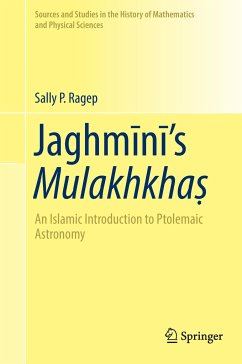This book provides the only critical edition and English translation of Mahmud al-Jaghmini's al-Mulakhkhas fi al-hay a al-basi a, the most widely circulated Arabic treatise on Ptolemaic astronomy ever written. Composed in the early 13th century, this introductory textbook played a crucial role in the teaching, dissemination, and institutional instruction of Islamic astronomy well into the 19th century (and beyond). Establishing the base text is a fundamental prerequisite for gaining insights into what was considered an elementary astronomical textbook in Islam and also for understanding the extensive commentary tradition that built upon it.
Within this volume, the Mulakhkhas is situated within the broader context of the genre of literature termed ilm al-hay a, which has become the subject of intensive research over the past 25 years. In so doing, it provides a survey of summary accounts of theoretical astronomy of Jaghmini's predecessors, both Ancient and Islamic, which could have served as potential sources for the Mulakhkhas. Jaghmini's dates (which until now remained unsettled) are established, and it is definitively shown that he composed not only the Mulakhkhas but also other scientific treatises, including the popular medical treatise al-Qanunca, during a period that has been deemed one of scientific decline and stagnation in Islamic lands. The book will be of particular interest to scholars engaged in the study of Islamic theoretical astronomy, but is accessible to a general readership interested in learning what constituted an introduction to Ptolemaic astronomy in Islamic lands.
Within this volume, the Mulakhkhas is situated within the broader context of the genre of literature termed ilm al-hay a, which has become the subject of intensive research over the past 25 years. In so doing, it provides a survey of summary accounts of theoretical astronomy of Jaghmini's predecessors, both Ancient and Islamic, which could have served as potential sources for the Mulakhkhas. Jaghmini's dates (which until now remained unsettled) are established, and it is definitively shown that he composed not only the Mulakhkhas but also other scientific treatises, including the popular medical treatise al-Qanunca, during a period that has been deemed one of scientific decline and stagnation in Islamic lands. The book will be of particular interest to scholars engaged in the study of Islamic theoretical astronomy, but is accessible to a general readership interested in learning what constituted an introduction to Ptolemaic astronomy in Islamic lands.
"This book is a full study of one of the most popular introductory works on theoretical astronomy in the Islamic world from the 13th to the 19th century ... . this is an important contribution to the history of Islamic astronomy which will be of interest to a wide audience of both specialists and non-specialists." (Benno van Dalen, zbMATH 1380.01007, 2018)
"Ragep provides a brief history of the scant historical evidence that introduces Ptolemy's predecessors and successors in the Hellenistic world. This brief history was absent in previous works on the history of hay a, and thus her account is quite helpful. ... The critical edition is well-prepared and the Arabic text (with an English translation) will be useful for researchers." (Hanif Ghalandari, Nazariyat, Vol. 4 (1), 2017)
"Ragep provides a brief history of the scant historical evidence that introduces Ptolemy's predecessors and successors in the Hellenistic world. This brief history was absent in previous works on the history of hay a, and thus her account is quite helpful. ... The critical edition is well-prepared and the Arabic text (with an English translation) will be useful for researchers." (Hanif Ghalandari, Nazariyat, Vol. 4 (1), 2017)

